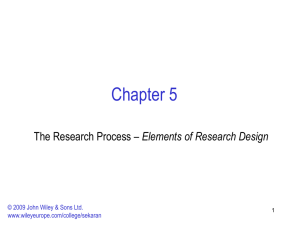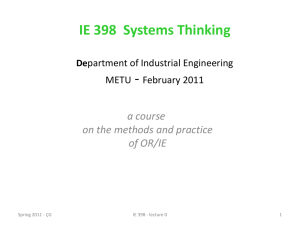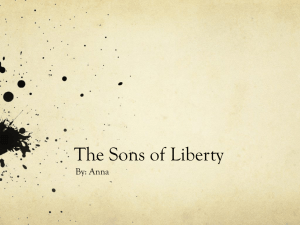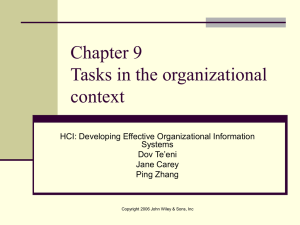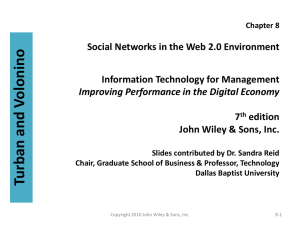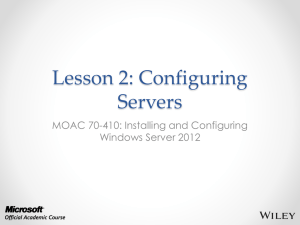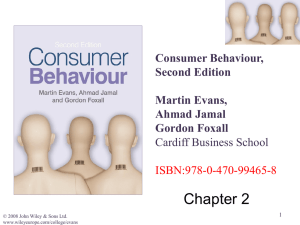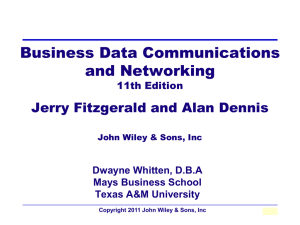Chapter 2 - General Informatics LLC
advertisement
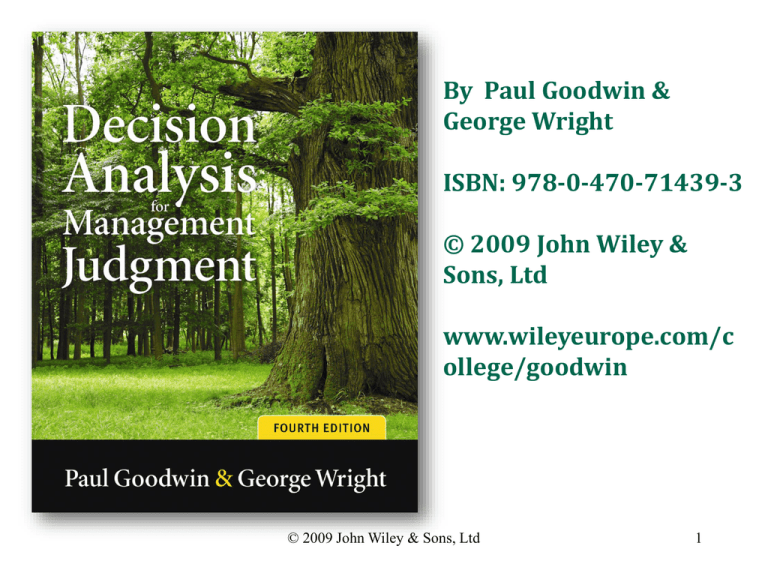
By Paul Goodwin & George Wright ISBN: 978-0-470-71439-3 © 2009 John Wiley & Sons, Ltd www.wileyeurope.com/c ollege/goodwin © 2009 John Wiley & Sons, Ltd 1 How people make decisions involving multiple objectives © 2009 John Wiley & Sons, Ltd 2 Examples of decisions involving multiple objectives • Choosing a holiday liveliest nightlife least crowded beaches most sunshine most modern hotels lowest cost • Choosing a company to supply goods best after-sales service fastest delivery time lowest prices best reputation for reliability © 2009 John Wiley & Sons, Ltd 3 Bounded rationality • The limitations of the human mind mean that people use “approximate methods” to deal with most decision problems • As a result they seek to identify satisfactory, rather than optimal, courses of action. • These approximate methods, or rules of thumb, are often referred to as “heuristics” © 2009 John Wiley & Sons, Ltd 4 Heuristics • These heuristics are often well adapted to the structure of people’s knowledge of the environment • Quick ways of making decisions, which people use, especially when time is limited, have been referred to as “fast and frugal heuristics” © 2009 John Wiley & Sons, Ltd 5 Compensatory v non compensatory strategies • Compensatory strategy -poor performance on some attributes is compensated by good performance on others - Not the case in a non-compensatory strategy. • Compensatory strategies involve more cognitive effort. © 2009 John Wiley & Sons, Ltd 6 The Recognition heuristic • Used where people have to choose between two options. • If one is recognized and the other is not, the recognized option is chosen • Works well in environments where quality is associated with ease of recognition © 2009 John Wiley & Sons, Ltd 7 The Minimalist strategy • First apply recognition heuristic, • If neither option is recognized, simply guess which is the best option. • If both options are recognized, pick at random one of the attributes of the two options and choose best performer on this attribute • If both perform equally well on this attribute, pick a 2nd attribute at random, and so on.. © 2009 John Wiley & Sons, Ltd 8 Take the last • Same as minimalist heuristic except that people use attribute that enabled them to choose last time when they had a similar choice • If both options are equally good on this attribute, choose the attribute that worked the time before, and so on. • If none of the previously used attributes works, a random attribute will be tried. © 2009 John Wiley & Sons, Ltd 9 The Lexicographic strategy • Used where attributes can be ranked in order of importance. • Involves identifying most important attribute and selecting option which is best on that attribute (e.g. choose cheapest option) • In there’s a ‘tie’ on the most important attribute, choose the option which performs best on the 2nd most important attribute, and so on. © 2009 John Wiley & Sons, Ltd 10 The semi-lexicographic strategy • like the lexicographic strategy -except if options have similar performance on an attribute they are considered to be tied • It can lead to violation of transitivity axiom…. © 2009 John Wiley & Sons, Ltd 11 Example… ‘If the price difference between brands is less than 50 cents choose the higher quality product, otherwise choose the cheaper brand.’ Brand Price Quality A $3.00 Low B $3.60 High C $3.40 Medium © 2009 John Wiley & Sons, Ltd 12 A is preferred to B B is preferred to C But: C is preferred to A © 2009 John Wiley & Sons, Ltd 13 Elimination by aspects (EBA) • The most important attribute is identified and a performance cut-off point is established. • Any alternative falling below this point is eliminated. • The process continues with 2nd most important attribute, and so on….. © 2009 John Wiley & Sons, Ltd 14 Example: Choosing a computer system Aspect 1: £45m price limit Aspect 2: Delivery time < 40 months Aspect 3: Must have training course provided System A B C D E F Price (£m) Del time (mths) Course? 60 55 No 32 35 No 44 59 Yes 70 68 Yes 25 67 Yes 44 38 Yes © 2009 John Wiley & Sons, Ltd 15 Example: Choosing a computer system Aspect 1: £45m price limit Aspect 2: Delivery time < 40 months Aspect 3: Must have training course provided System A B C D E F Price (£m) Del time (mths) Course? 60 55 No 32 35 No 44 59 Yes 70 68 Yes 25 67 Yes 44 38 Yes © 2009 John Wiley & Sons, Ltd 16 Example: Choosing a computer system Aspect 1: £45m price limit Aspect 2: Delivery time < 40 months Aspect 3: Must have training course provided System A B C D E F Price (£m) Del time (mths) Course? 60 55 No 32 35 No 44 59 Yes 70 68 Yes 25 67 Yes 44 38 Yes © 2009 John Wiley & Sons, Ltd 17 Example: Choosing a computer system Aspect 1: £45m price limit Aspect 2: Delivery time < 40 months Aspect 3: Must have training course provided System A B C D E F Price (£m) Del time (mths) Course? 60 55 No 32 35 No 44 59 Yes 70 68 Yes 25 67 Yes 44 38 Yes © 2009 John Wiley & Sons, Ltd 18 Strengths & Limitations of EBA • • • • Easy to apply Involves no complicated computations Easy to explain and justify to others. Fails to ensure that the alternatives retained are superior to those which are eliminated. - this arises because the strategy is noncompensatory. © 2009 John Wiley & Sons, Ltd 19 Sequential decision making: Satisficing • Used where alternatives become available sequentially • Search process stops when an alternative is found which is satisfactory in that its attributes’ performances all exceed aspiration levels • These aspiration levels themselves adjust gradually in the light of alternatives already examined. © 2009 John Wiley & Sons, Ltd 20 Reason-based choice • Shafir et al: “when faced with the need to choose, decision makers often seek and construct reasons in order to resolve the conflict and justify their choice to themselves and to others”. © 2009 John Wiley & Sons, Ltd 21 Some consequences of reason-based choice • Decisions framed as “choose which to select…” can lead to different choices to those framed as “ choose which to reject” • Irrelevant alternatives can influence choice • Attributes can be rejected if they have weakly favorable or irrelevant attributes © 2009 John Wiley & Sons, Ltd 22 Example of reason-based choice Candidate A Candidate B Average written communication skills Excellent written communication skills Satisfactory absenteeism record Very good absenteeism record Average computing skills Excellent computer skills Reasonable inter-personal skills Awkward when dealing with others Average level of numeracy Poor level of numeracy Average telephone skills Poor telephone skills © 2009 John Wiley & Sons, Ltd 23 Factors that affect how people make choices • Time available to make decision • Effort that a given strategy will involve • Decision maker’s knowledge about the environment • Importance of making an accurate decision • Whether or not the choice has to be justified to others • Desire to minimize conflict (e.g. conflicts between the pros and cons of the alternatives). © 2009 John Wiley & Sons, Ltd 24 Decoy effects Sports car with free insurance Image of car You can’t make your mind up Saloon with free insurance Offer elsewhere of Saloon car without free insurance makes this deal look attractive You choose the saloon! © 2009 John Wiley & Sons, Ltd Space for family & luggage 25 Phantom decoys Price discount on cheap Cheap laptop laptop You can’t make your mind up Expensive laptop Weight of laptop (kg) Offer of price discount on cheap laptop makes it look more attractive -even though the offer is no longer available Cost of laptop ($) © 2009 John Wiley & Sons, Ltd 26 Choice by unique attributes Destination A Good restaurants Destination B Lots of good nightspots Destination C1 Lots of good nightspots Most people chose A Destination A Good restaurants Destination B Lots of good nightspots Destination C2 Good restaurants Most people chose B © 2009 John Wiley & Sons, Ltd 27 Emotion and choice • Sad moods prompt detailed analytic thinking • Happy moods –less detailed analysis • ‘Affect heuristic’ –feeling generally positive or negative about a decision option influence one’s perceptions of the risks or benefits it might bring © 2009 John Wiley & Sons, Ltd 28 Justifying choices already made People asked to rate relative importance of aspects of different jobs Then asked to choose a job The asked to re-rate relative importance of job aspects Revised ratings shifted to provide stronger support for the favored job © 2009 John Wiley & Sons, Ltd 29 Partitioning the total cost of an item changes preferences • Cost of a television A: $199 + $30 shipping Option A appeared to be more attractive B $229 including shipping © 2009 John Wiley & Sons, Ltd 30

